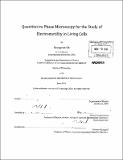Quantitative phase microscopy for the study of electromotility in living cells
Author(s)
Oh, Seung-eun
DownloadFull printable version (12.08Mb)
Other Contributors
Massachusetts Institute of Technology. Dept. of Physics.
Advisor
Michael Stephen Feld.
Terms of use
Metadata
Show full item recordAbstract
The electric activity of living cells is accompanied with changes in their optical and mechanical properties, which arise from the intrinsic biophysics of the cell membrane. These intrinsic changes can be used as an indicator for cell electric activity, but, to our knowledge, the intrinsic signal of electric activity has never been detected in single vertebrate cells. We describe here our development of a quantitative phase microscopy technique that is capable of detecting the intrinsic changes induced by electric activity in a human cell line. Chapter 1 provides introductory material regarding cellular electrophysiology and a review of the literature on the intrinsic signal of cell electric activity. This chapter also briefly introduces the quantitative phase microscope. In Chapter 2, we discuss our pilot studies and introduce the electromotility of prestinexpressing HEK293 cells as a test system. We describe our design of an effective optical detection scheme based on quantitative phase imaging and frequency domain detection which provides full-field, high resolution, high sensitivity, quantitative detection of electrically induced optical signals in cells. In Chapter 3, we demonstrate an improved quantitative phase microscope based on low-coherence interferometry with enhanced sensitivity and lower noise. We successfully acquired images of the intrinsic optical signal from electrically stimulated single HEK293 cells. In Chapter 4, we characterized the electrochemical properties and dynamic properties of the intrinsic optical signal. We argue that the signal is generated through the electromechanical coupling mechanism called membrane electromotility (MEM). Using the MEM signal as an indicator of membrane electric activity, we imaged the propagation of an applied potential in a network of cells in Chapter 5. Our research shows that high resolution quantitative phase imaging is a powerful tool that can provide significant insight into the underlying mechanism of cellular intrinsic optical signal of electric activity. Membrane electromotility imaging provides a novel opportunity for the visualization of the electrical connectivity of cultured cells.
Description
Thesis (Ph. D.)--Massachusetts Institute of Technology, Dept. of Physics, 2010. Cataloged from PDF version of thesis. Includes bibliographical references (p. 118-123).
Date issued
2010Department
Massachusetts Institute of Technology. Department of PhysicsPublisher
Massachusetts Institute of Technology
Keywords
Physics.